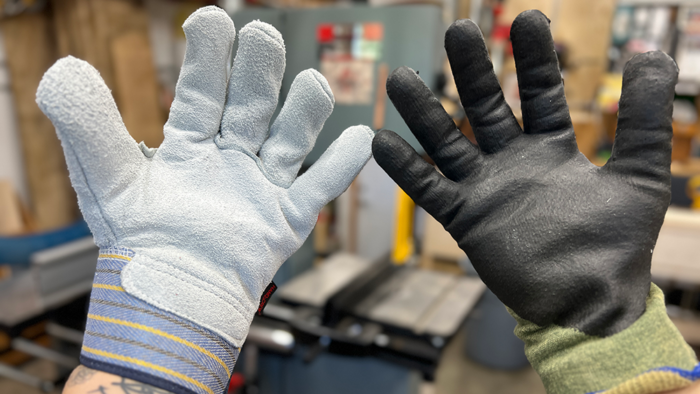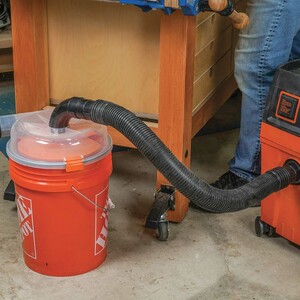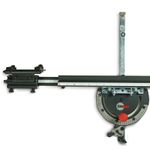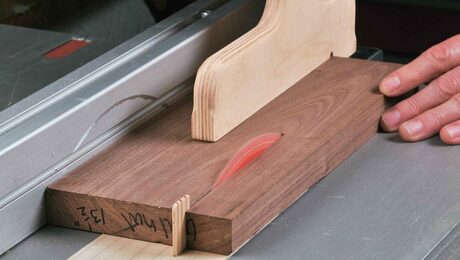Gloves are on
There's nothing inherently unsafe about pairing gloves and woodworking, if you use the right kind.
Social media. A place of sharing, liking, and connecting with people all over the globe. As we all know, sometimes this sharing leads to discussion and debate in the form of comments and replies. I’ve realized that if ever you want to illicit a strong response from the safety police on social media, simply post a photo or video of doing various woodworking tasks while wearing a pair of gloves. Yes, gloves! In some cases, I disagree with the wisdom of wearing gloves, but that has more to do with the type of gloves and the task being done. For the purposes of this post, let’s refer to the left-hand glove as “lefty” and the right-hand glove as “righty.”
To the left
Not long ago, there wasn’t much choice when it came to work gloves. When most of us of a certain age think of work gloves, we often think of lefty—thick, leather, often loose-fitting gloves that could be used for almost anything from gardening to handling rough lumber. I used these gloves often for many heavy tasks to protect my hands from scrapes and minor nicks, and in some cases the gloves would add an element of grip to help with the work. They came on and off quickly and a nice pair would age well, breaking in like a nice pair of shoes.
All that said, you would never wear them to put wood through machines. They have a lot of material between your fingers and the blades, which makes it difficult to judge how close your digits are to the blade. As well, the loose, floppy material could get pulled into a machine, taking your hand with it. Not a great thing to imagine; I’m flexing my hands as I type this trying to shake the feeling. It feels dangerous just thinking about it and it is, in fact, very dangerous. Try not to ignore those gut feelings when you get them.
To the right
If we turn our attention to righty, we have a completely different situation. To start, righty is form-fitting and hugs the fingers, hand, and wrist. The material is normally stretchy, which provides this fit. The fingers and palms have a rubber-like coating on them which provides the wearer with great grip and friction. This non-slip aspect is great for handling wood at machines and, depending on the type of gloves purchased, there is an element of cut-resistance. This cut-resistance is not designed to prevent an amputation at the bandsaw, but it can be helpful when carving to prevent an errant slip from drawing blood.
The most important aspect of righty is the snug fit and thin material they are made of. You can see where your hands are while wearing them and the extra 1-2mm of thickness poses no additional danger to being pulled into a machine than your bare hands. Hands should be nowhere near any blade on any machine. Full stop.
Trust your gut
Ultimately, you have to do what is right for you and how you work. I like wearing tight, rubberized gloves when milling because I feel like I have better grip and therefore, more control over what I’m doing. If you don’t feel that way and prefer bare hands, then don’t wear gloves. Just understand that wearing the right type of gloves is no more dangerous than working without them. The choice is yours, but work safe and have fun in the shop.
More from Vic Tesolin
Fine Woodworking Recommended Products

Rockler Dust Right 1250 CFM

Dustopper Pro

Sawstop Miter Gauge
























Comments
I've worn gloves for decades and never had an issue. I prefer gloves with the thumb, and two first fingers without a tip keeping my 'working' digits in contact with the wood (like these: https://www.amazon.com/gp/product/B0000950R5/ref=ppx_yo_dt_b_search_asin_title?ie=UTF8&th=1). The rest of the glove, as you say above, is form fitting. I think as long as you obey basic safety rules (never get your hand within two inches of the blade, etc.) and pay attention when you're milling, you'll never have an issue.
I second rrehart on following all the standard safety rules. Don't wear any lose clothing that could get caught and pull you into a machine. Jewelry of any kind can be a hazard. Your hand is not a vise. Never work tired, in a hurry or frustrated and never let your fingers get with 3" of a blade
I buy my gloves from the place down at the Harbor that sells all the cheap Freight. They have some that are made of an elastic knit material with a grippy rubber coating on the fingers and palms. They stay tight on your hands and away from spinning bits and blades but stretch when you move. I've been wearing them for a decade or more all year around and feel the extra grip gives me a lot more control.
You nailed it again Vic.
Be Safe and have fun.
"Well I never had an issue!" well yah, if you haven't had an injury it's not an issue. But gloves can and will make a bad injury into a catastrophic one
Shame on you FWW for putting this out there. This is a well established fact that gloves and machines are bad. We would never teach our students this. There are far too many reported injuries out there of gloves getting pulled into machinery.
If you were looking for social media engagement, bravo, you found something to create controversy over. But as a steward to the craft, this is terrible. Shame on you FWW and shame on you Vic, I had a lot of respect for you, but the amount you are pushing this really leaves me with a bad taste.
Log in or create an account to post a comment.
Sign up Log in